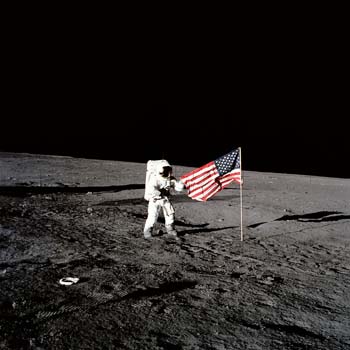Moon landing fascinates even 40 years after "one small step"
 Washington - Forty years ago, millions gathered around grainy black and white television images as the first man set foot on the moon, in what remains for many the pinnacle of manned spaceflight.
Washington - Forty years ago, millions gathered around grainy black and white television images as the first man set foot on the moon, in what remains for many the pinnacle of manned spaceflight.
That moon landing on July 20, 1969, was the first of just six times that any human being has visited the Earth's nearest celestial neighbour, and it has been more than 30 years since any person has been there.
In the decades since Apollo 11 astronauts Neil Armstrong and Buzz Aldrin first touched the surface of the moon in the Eagle lander, the moment has become one of the iconic images of the 20th century.
At the National Air and Space Museum in Washington, many of the visitors old enough to remember that day tell their children and grandchildren about where they were when man first set foot on the moon as they point at the Columbia spacecraft that carried the astronauts there.
But even as the memories remain clear to many and thousands view the artefacts, an entire generation has grown up without seeing humans on the moon.
Curator Allan Needell notes that visitors respond differently to the collection depending on how old they are.
"It's always interesting to watch the older grandfathers and the the fathers walking around with their kids, and basically telling their experiences," he said in an interview. "For the younger kids this is not much different really than than the Spirit of St Louis (the plane flown non-stop from New York to Paris by Charles Lindbergh) or the Wright flier. It's this historical object that they studied in seventh grade or ninth grade."
The Apollo 11 landing was the culmination of a decades-long space race between the United States and the Soviet Union, which launched the first satellite and put the first man in space. Both nations pitted their Cold War drive for superiority in the battle for technological prominence. US president John F Kennedy in 1961 responded by proclaiming the US desire to put a man on the moon within the decade.
But the accomplishment was far from certain - a fire during a test of Apollo 1 killed three astronauts and set back the programme. Then, even as Armstrong steered his craft in for landing on the moon, things could have gone horribly wrong.
In fact, president Richard Nixon had prepared a speech to deliver in case the astronauts did not return.
As Armstrong steered the Eagle in for landing, he noticed the craft drifting and had to correct its landing site to avoid a rough patch of ground. A computer glitch also caused concern on the ground.
But the world breathed a sigh of relief as Armstrong radioed back: "Tranquility base here. The Eagle has landed."
"Fortunately, there were no really harrowing parts of the flight," Armstrong said in a 2001 interview with historians. "The most difficult part from my perspective, and the one that gave me the most pause, was the final descent to landing."
"Walking around on the surface, you know, on a 10 scale, was one, and I thought that the lunar descent on a 10 scale was probably a 13."
Just hours later Armstrong stepped out of the craft onto the lunar surface, reciting the famous words, "That's one small step for (a) man, one giant leap for mankind."
He was followed by Aldrin, and together they focussed on testing gravity, photographing the surface and collecting rock samples. They also left behind a US flag, messages from world leaders and other artefacts.
Meanwhile, fellow crew member Michael Collins orbited the moon in the Columbia module that served as a command centre and would bring them all back to Earth.
After spending the night on the surface in the Eagle, the astronauts lifted off for a rendezvous with the Columbia and their return trip.
The Eagle itself remained on the lunar surface. A similar lunar lander that was never used in space is on display in Washington and was recently restored with the replacement of degraded foil coverings.
There is a small, but vocal, group of skeptics and conspiracy theorists who have continued to insist that the moon landing never happened and was simply filmed on Earth - a point debunked by historians, astronauts and curators who hold lectures on the myths.
But even those who accept the historical record wonder why no one has returned to the moon since the 1970s. That could soon change, as NASA is working to develop the next-generation moon craft with a goal of returning astronauts to the surface by 2020.
Scientists cite the desire for continued exploration and inspiration that could come from such efforts, including using the moon as a base for eventually heading to Mars. As they move forward, they also look back for lessons from Apollo, both technological and symbolic.
For as Armstrong said decades later: "The important achievement of Apollo was a demonstration that humanity is not forever chained to this planet, and our visions go rather further than that, and our opportunities are unlimited." (dpa)